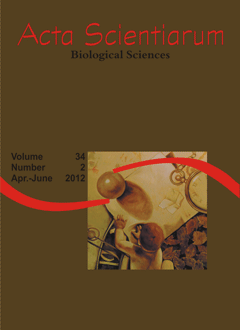<b>Glycosaminoglycans isolated from the skin of ‘palombeta’ (<i>Chloroscombrus chrysurus</i>) and ‘guaiúba’ (<i>Ocyurus chrysurus</i>): features and biological implications</b> - doi: 10.4025/actascibiolsci.v34i2.6056
Abstract
A great number of pharmacological compounds is found in the Brazilian marine diversity. This study evaluated the anticoagulant potential of glycosaminoglycans (GAGs) isolated from the skin of ‘palombeta’ Chloroscombrus chrysurus and ‘guaiúba’ Ocyurus chrysurus. GAGs were extracted with crude papain in 0.1 M sodium acetate buffer (pH 5.0) containing 5 mM cysteine and 5 mM EDTA, followed by ion exchange chromatography on DEAE-cellulose column. The chemical composition (contaminant proteins and total carbohydrates) and the analysis by 0.5% agarose gel electrophoresis of fractions were also determined. Anticoagulant assays were performed by activated partial thromboplastin time (APTT) using normal human plasma and standard heparin (193.00 IU mg-1). The obtaining and fractionation procedures of GAGs were effective and similar chromatographic profiles were verified between the species. A similar mobility to dermatan sulfate was revealed for C. chrysurus. This GAG also showed a low activity of 3.30 IU mg-1.
Downloads
DECLARATION OF ORIGINALITY AND COPYRIGHTS
I Declare that current article is original and has not been submitted for publication, in part or in whole, to any other national or international journal.
The copyrights belong exclusively to the authors. Published content is licensed under Creative Commons Attribution 4.0 (CC BY 4.0) guidelines, which allows sharing (copy and distribution of the material in any medium or format) and adaptation (remix, transform, and build upon the material) for any purpose, even commercially, under the terms of attribution.
Read this link for further information on how to use CC BY 4.0 properly.












1.png)




3.png)













